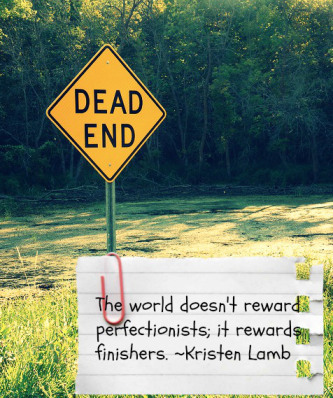NaNoWhatNow? Three Tactics for Getting Un-Stuck

Image via Flickr Creative Commons, courtesy of Mike Renlund
One of the reasons I LOVE NaNoWriMo (National Novel Writing Month, which is November) is it gives new writers a glimpse of a professional pace. It teaches discipline, writing no matter what, how we feel or whether or not we’re inspired. Writing is a profession, not a playpen. I remember when I was new thinking that 500 words a day was such a BIG DEAL.
Now? I generally have 1200 words written before breakfast. My daily average can range from 1000-6000 words, depending on what I’m doing, how many projects I have going, etc.
I also love NaNoWriMo because it employs one of my favorite techniques, Fast Draft. Wear out the inner editor and the subconscious can come up with some pretty amazing stuff. This technique isn’t for everyone, but I do recommend trying a little of everything when we’re in the beginning stages of our career. Eventually, if we stick with it, we’ll find out what works. I LOVE Fast Draft because I’m, at heart, an editor.
I can nitpick until the prose screams and taps out.
Perfect prose is wonderful (though imaginary—-someone will always hate it). But, the world doesn’t reward perfection; it rewards finishers. So if you took the NaNo challenge (or even did a Fast Draft on your own) odds are you might find yourself stuck. It happens to us all.

Image via Marie Loughin WANA Commons
I finally finished my mystery-thriller. I fast-drafted it and finished it in a month—70,000 words. I wrote it right after I fast-drafted my NF and newest best-selling book Rise of the Machines–Human Authors in a Digital World. NF is left-brain. Left-brain was tired and needed time to marinate over what I’d written. Right-brain was bored and coloring on the walls and eating Play-Doh. So, while left-brain was resting and contemplating its belly-button, I put right-brain to work.
This gave me time to subconsciously ponder the NF while plowing through the fiction. Change is great. Get out of the house and out of your head and many times roadblocks will melt away. Read other books, watch movies, read some NF to feed and refresh your subconscious. In time? You’ll see what magic it can create ;).
Then I had to travel all spring and summer and finish and publish ROM, so I set the fiction down. Then we had WANACon and then my world went KABLOOEY personally, but all of that was fine, because I was still working on the fiction, rolling it over in my mind. I’d written four different endings and they were “good” but not “good enough.” Something was missing.
Maybe you finished the 50,000 words. Odds are, you hit somewhere between 20,000-35-000 and were stuck like a Ford Fiesta in icy mud. This is one of the reasons I recommend at least getting the log-line and basic plot points before beginning any fast-draft. If we don’t, we might find it hard to locate our literary butt with a literary flashlight.
But, I’ve been stuck and here are some tips.
Take a Break
Too many people dive into revisions right away. Take at least two days. Two weeks is better. Two months? Might take that long. Write your blog posts for the next week or month. Let the fiction simmer for a while and often problems will become clearer. Sometimes we can’t see the forest for the trees. Get away. Start plotting/fast-drafting the next novel. The human mind is an amazing thing. It will still be working on the other book, so expect some weird dreams.
Take a Different Path
Find a place where your character/story hit a wall? Nothing is happening? Back up. Can the protagonist make a different decision? As writers, we must guard against sanity. Sanity is our enemy. Great fiction comes from dumb, bad, miscalculated choices. If our protagonist is so evolved that he/she always has the right answers? Never makes emotional decisions guided more by baggage than logic? SNOOZE FEST.
You might even find yourself resistant to a certain direction. Why? Because it’s the correct path. It’s the uncomfortable path.
Discomfort=Dramatic Tension
Readers crave resolution. All humans do. We don’t like unresolved problems. This is how we get readers to turn pages faster and put our next book on their wish-list (if we have a series).
In my novel that I finally finished yesterday, the protagonist’s greatest strength is also her greatest weakness. She sees the best in people and tends to ignore her gut when red flags go up. She has to grow. Why I didn’t like those four other endings was they all had an HEA (Happily Ever After). But, that didn’t work with this book as much as I tried. There was only ONE ending that would satisfy. It’s dark, heart-wrenching…but (hopefully) satisfying. It was the ONE ending I didn’t want to write, but it was the only ending that tied up all loose threads in the mystery and demonstrated true character arc.
Take a Different POV/Recast
I’ve won multiple awards for short fiction, but have struggled when it comes to writing a full-length novel (though I can plot and edit them all day for others). Why? Because I LIKE strong female characters. Ah, but the trick is how to make a woman strong, and not be viewed as a b!*&%. Originally, I wrote virtually the same story as the one I just finished, but in close third. Everyone LOVED my supporting characters…and hated my protagonist.
No matter how many times I rewrote it? People did not like my protagonist (which is a problem). What did I do? I changed POV. I switched out deep third for first-person and this infused more of my humor I naturally use in blogging. Also, instead of a female war vet, I chose a disgraced salesperson who’d been blackballed by her fiancé who’d stolen billions of dollars and left her as the FBI’s prime suspect.
She’s strong because she came from the trailer park and grew up in a family straight from The Jerry Springer Show…not because she was a soldier. She ran away to go to college, knowing it was her escape from The Cactus Flower Trailer Park…only to have to go home because she’s out of money and options. She has to face the demons of her past and new demons she never knew existed.
Suddenly? Beta readers were in love. Final version of The Devil’s Dance (working title) is 97,000 words (which is square in the ballpark for a mystery-thriller’s word count). Will cut some away, but overall? I am VERY happy with the story.
I can apparently write likable/believable male military characters, but the female? Yeah….
I had to redefine what a STRONG female was. Did she have to be a former MP when a Waffle House waitress who works the drunks at 2:00 a.m. might be more relatable and interesting?
Cool thing is, I now have an option. I can go back and rewrite the same book in close third and then see if just changing perspective removed the coldness readers were feeling in the first go-round. If not? Then maybe first-person is my thing. Try switching POVs and see if that doesn’t fix the problem.
Have you been stuck? Are you stuck? Any tips? Advice? War stories?
I love hearing from you!
To prove it and show my love, for the month of December, everyone who leaves a comment I will put your name in a hat. If you comment and link back to my blog on your blog, you get your name in the hat twice. What do you win? The unvarnished truth from yours truly. I will pick a winner once a month and it will be a critique of the first 20 pages of your novel, or your query letter, or your synopsis (5 pages or less).
I hope you will check out my newest book Rise of the Machines–Human Authors in a Digital World onAmazon or even Barnes and Noble.
Also, here is a list of WANA International classes and Christmas specials.






